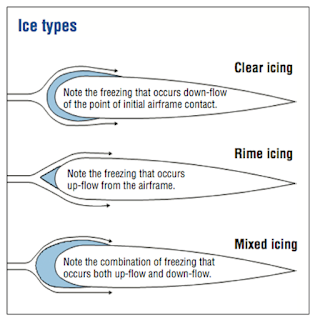Aircraft icing is one of the major weather hazards to aviation. It can reduces aircraft efficiency by increasing weight, reducing lift, decreasing thrust, and increasing drag. Icing also seriously impairs aircraft engine performance. Other icing effects include false indications on flight instruments, loss of radio communications, and loss of operation of control surfaces, brakes, and landing gear.
Two conditions are necessary for structural icing in flight:
(a) The aircraft must be flying through visible water such as rain or cloud droplets.
(b) The temperature at the point where the moisture strikes the aircraft must be 0° C or colder.
Supercooled water increases the rate of icing and is essential to rapid growth. Supercooled water is in an unstable liquid state when an aircraft strikes a supercooled drop, part of the drop freezes instantaneously. The latent heat of fusion (heat energy involves when melting and freezing) released by the freezing portion
raises the temperature of the remaining portion to the melting point. Aerodynamic effects may cause the remaining portion to freeze.
The types of structural icing are:
1) Clear ice
2) Rime ice
3) A mixture of the two
4) Frost
**Effect of Icing
In general, effect of icing are:
1) Aerodynamics
Ice forms on leading edges and spoils the aerodynamics shape;
results in reduced lift, increased drag, weight, stalling speed and
fuel consumption.
2) Weight
Can be loss of stability due to weight of ice not being uniform
across the airframe and therefore affects center of gravity.
3) Instrument effects
Ice can block pressure heads causing errors in reading.
4) General
Windscreens can be obscured; a film of ice can cause skin friction;
ice in landing gear wells can affect retraction.
Sources:
https://www.aopa.org/…/Pilot-R…/ASI/Safety-Advisors/sa11.pdf
http://www.aviationchief.com/icing.html
https://www.faa.gov/…/advisor…/ac%2000-6a%20chap%2010-12.pdf















ليست هناك تعليقات:
إرسال تعليق